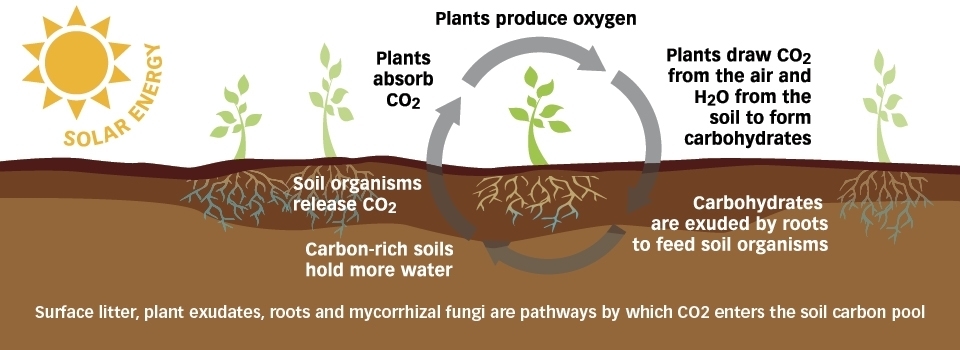– leaving the carbon rich soil structure intact
“The new buzz word among politicians and companies as well as among farmers.”
.
Marianne Landzettle writes in the latest Sustainable Food Trust about the latest idea in farming:
A mixed picture: Climate change mitigation, carbon and greenwashing
At least this much is clear: the only way to tackle the climate crisis is a global effort to reduce CO2 levels in the air and to do it fast. The UK, the EU and the US have all pledged to reach a net zero target by 2050. Any approach to CO2 reduction must be two-pronged: we need to end CO2 emissions to stop the crisis from getting worse, and we have to actively reduce the amount of CO2 in the air by capturing and sequestering it, to mitigate the consequences of global warming that we are already experiencing.
Agriculture contributes to CO2 emissions but because of the ability of the soil to store carbon long term, it also offers a chance for climate mitigation. In good soil with an abundance of mycorrhiza, microorganisms and earthworms, much of the carbon that plants remove from the air through photosynthesis will bind with soil particles and thus be stored – unless the soil is ploughed or doused in pesticides. And that’s why ‘carbon farming’ – leaving the carbon rich soil structure intact – has become the new buzz word among politicians and companies as well as among farmers.
Talk to any farmer these days and chances are that they had a call, in recent months, enquiring whether they were interested in a ‘carbon farming contract’. After Brexit, with direct payments being phased out, such contracts could potentially become a new income stream. Last summer, the magazine Farmers Weekly listed no fewer than six companies offering “carbon-based payments to arable farmers” – among them start-ups as well as big players such as Bayer and Indigo Ag (last year’s number 14 on the US list of ‘disruptor’ companies, “poised to emerge from the pandemic as the next generation of billion-dollar businesses”. The reason? Companies the world over are scrambling to become carbon neutral. Even with their best efforts, most will continue to produce some CO2. In order to ‘offset’ it, they will want to or have to buy ‘carbon credits’ and these can be issued, for example, by companies that pay farmers to sequester carbon.
The Carbon Cycle Institute explains what it’s all about:
What is Carbon Farming? | Carbon Cycle Institute
With an info-graphic to help:

The BBC looked at it last year, taking us around the UK:
Carbon farming seeks to capture emissions, not create them. The challenge has been to make this form of regenerative farming financially viable, paying landowners to rejuvenate degraded soils by turning their fields into vast CO2 sponges.
Achieving this requires a range of regenerative techniques. Cover cropping is particularly popular – fields blanketed with grasses, cereals, legumes and other plant life that pull carbon from the air during photosynthesis, then store it in the soil below. After a couple of years and some meticulous measurements to show the changing carbon content of the soil, the sequestered carbon is certified and transferred into credits, before being sold.For its proponents, carbon farming promises a bold new agricultural business model – one that tackles climate change, creates jobs and saves farms that might otherwise be unprofitable.
Having spent decades on the fringes of the agriculture community, carbon farming is starting to catch on. The European Commission is promoting the practice as part of its new Farm to Fork Strategy, with the launch of an EU-wide carbon credit market expected later this year. Similar moves are underway in the United States, with the recent passage of a carbon-focused Growing Climate Solutions Act, and in the UK, where private projects are springing up at pace.
The regenerative revolution in food – BBC Future
And the Guardian visited New South Wales last month:
To finish, a short video from the Continent gives a good overview:
.